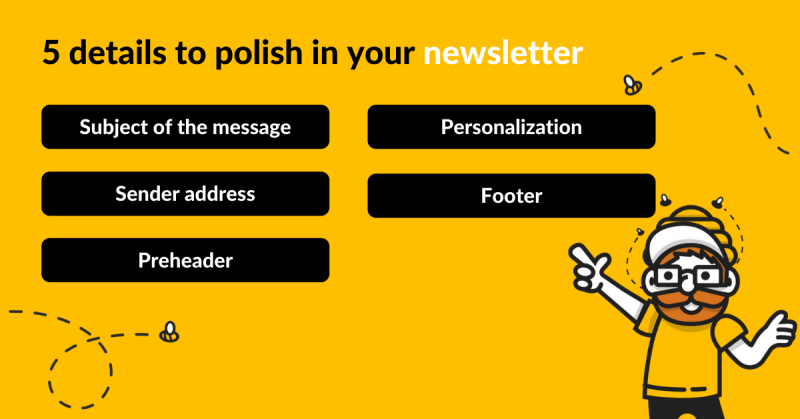When it comes to writing newsletters, the devil is in the details, and they largely determine the success of the newsletter – a small mistake in one of them may cause the message to land in the “spam” box or be ignored by the potential reader. Check out how to polish 5 details in your newsletter to perfection and increase its chances of getting to the right inbox.
1. Subject of the message
It would seem that the news headline is the one you see when you open your newsletter, but at this point try to look at it from a slightly different angle. Imagine that your inbox is like a daily newspaper, and the news topics are just article headlines. Usually, you won’t even pay attention to an article started by an uninteresting or incomprehensible headline – so the last thing you want to do would be to send a message with a subject line that doesn’t appeal to the recipient.
A crucial part of your newsletter theme is credibility and trust – structure it from the first word. What does this mean? First of all, it means abandoning practices often used by short-sighted marketers, i.e., the so-called click-bait (e.g., “Earn a million Euros in a year” as the subject of a message with an offer of a business bookstore) or placing information unrelated to the content of the message itself. After one such content disappointment, most likely no one will open another email from you.
Instead of manipulation, focus on relationship – emphasize in the subject line a benefit to the recipient or something that may be important to her/him, such as asking a question that you often hear from customers.
Highlight the benefits to the recipient (discount, free materials, unique opportunity, answer an intriguing question).
Once you have the right content, take care of the form:
- keep it short and concise,
- don’t use TOO MANY CAPITAL LETTERS,
- eliminate lots of exclamation points!!!!!!!!,
- if possible, write without using the word “test” (may result in the message being considered spam),
- 20% off for you today only! and Are you a photographer? Submit your photo and win valuable prizes! are examples of good news topics.

2. Sender address
It may seem that hardly anyone pays attention to such a small detail as the sender’s address, but it makes a difference. It is another small detail with which we can create a positive relationship with the recipient and build the image of a professional and trustworthy brand.
How to do it? First of all, by using a company domain, and not a free one, which makes the email address look like a private one misleading the recipient.
Apart from the domain, we still have to choose an appropriate sender name. Here companies use various solutions, e.g., [email protected], but one of them has a clear advantage over the others: the use of the first name or the first and last name of a real company employee, e.g., [email protected]. In the displayed sender name, you can include the first name and brand, e.g., Andrew from [Company Name].
According to Marketing Sherpa’s test, using such a sender address increased the message open rate by 137% (compared to a message sent from a non-personal address). There’s a certain logic to this – although we’re moving into the realm of online marketing, there still are real people on the other end. They are the ones we communicate with.
3. Preheader
If this is a new word to you, let us explain: the preheader is the first sentence of an email message. It’s displayed in many email clients even before the email is opened. It’s another small element that shapes the image of the sender. Unfortunately, many marketers fail to use its potential. What kind of preheader do we see most often? Click if you don’t see this message correctly. Doesn’t sound very inviting. It’s time for a change!
Treat the preheader as an extension of the subject line, an introduction to the content of the entire newsletter. You’ll often feel like you can’t include everything you want in the subject line, and that’s when it’s ideal to put additional content in the preheader. You can place it with the link to the online message elsewhere in the newsletter, e.g., at the end of the content itself or under the headline. You won’t lose anything by doing this, but you can gain a more thoughtful and attractive message for the recipient.
4. Personalization
Paradoxically, it concerns the most important word for any human being, namely, name. There isn’t a person who won’t respond to their name, whether spoken or written. This is why personalization is so important in marketing. When collecting contacts for your mailing database, it’s a good idea to at least ask for a first name.
When creating your newsletter content, you can greet the reader as if you were writing a message just for them. Nothing shortens the distance in communication like addressing someone by name.
5. Footer
This is probably the most neglected element of newsletters. Many people simply skip it or use a painfully standard formula – putting basic contact information in a small font size, as if they wanted no one to notice what is actually written there. Meanwhile, the footer can also make an impression – and it’s not difficult!
Putting essential contact information in the footer isn’t a mistake. However, it is worth paying attention to how much of this data is actually useful. If the footer of your message covers more than 6 lines, you can be sure that nobody will read the whole thing. It is better to include less information, but in an attractive and readable form.
Speaking of form, why not spice up the text with graphics? It can be designed so that it creates a coherent whole with the visual identification of the company, which will be a great complement to the brand presentation in the newsletter. It is advisable not to overdo it – a footer which is too big may disturb the proportions of the whole message and distract from the actual content.
A very important part of the footer is the unsubscribe link. If you make this process difficult for your recipients, they will most likely take a shortcut and mark it as spam, which is directly related to problems with delivering subsequent newsletters. It’s not worth complicating your subscribers’ lives.
As we’re already in the topic of sending e-mail, why don’t you check out our blog post about e-mail marketing campaigns?
Will you now look at your emails with a completely different perspective? We hope so! Sometimes all it takes is a small change to make a big impact. See your yourself if it brings about positive outcomes.
Author: Zofia Lipska
With over 10 years of experience in digital marketing, Sophia not only knows the rules of this industry but above all knows how to break them in order to achieve outstanding and creative results.














